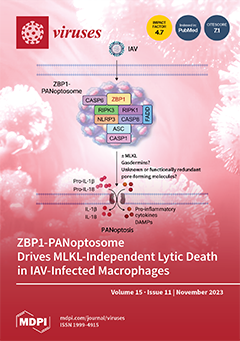Rift Valley fever phlebovirus (RVFV) is a zoonotic pathogen that causes Rift Valley fever (RVF) in livestock and humans. Currently, there is no licensed human vaccine or antiviral drug to control RVF. Although multiple species of animals and humans are vulnerable to RVFV infection, host factors affecting susceptibility are not well understood. To identify the host factors or genes essential for RVFV replication, we conducted CRISPR-Cas9 knockout screening in human A549 cells. We then validated the putative genes using siRNA-mediated knock-downs and CRISPR-Cas9-mediated knock-out studies. The role of a candidate gene in the virus replication cycle was assessed by measuring intracellular viral RNA accumulation, and the virus titers were analyzed using plaque assay or TCID
50 assay. We identified approximately 900 genes with potential involvement in RVFV infection and replication. Further evaluation of the effect of six genes on viral replication using siRNA-mediated knock-downs revealed that silencing two genes (
WDR7 and
LRP1) significantly impaired RVFV replication. For further analysis, we focused on the
WDR7 gene since the role of the
LRP1 gene in RVFV replication was previously described in detail.
WDR7 knockout A549 cell lines were generated and used to dissect the effect of
WRD7 on a bunyavirus, RVFV, and an orthobunyavirus, La Crosse encephalitis virus (LACV). We observed significant effects of
WDR7 knockout cells on both intracellular RVFV RNA levels and viral titers. At the intracellular RNA level,
WRD7 affected RVFV replication at a later phase of its replication cycle (24 h) when compared with the LACV replication, which was affected in an earlier replication phase (12 h). In summary, we identified
WDR7 as an essential host factor for the replication of two different viruses, RVFV and LACV, both of which belong to the
Bunyavirales order. Future studies will investigate the mechanistic role through which
WDR7 facilitates phlebovirus replication.
Full article






